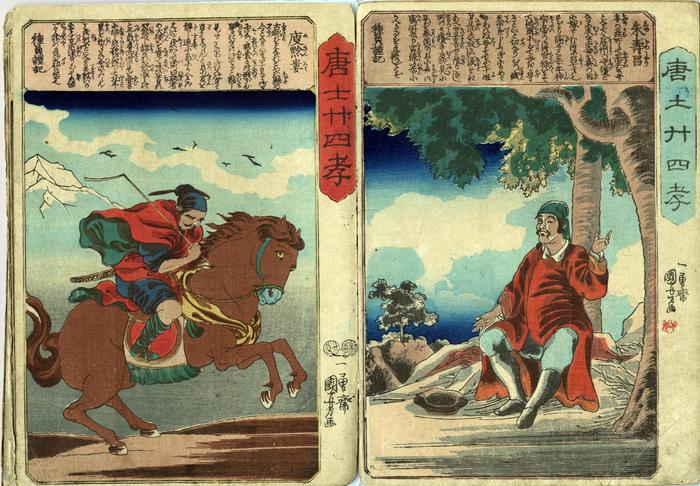Utagawa Kuniyoshi (歌川国芳) (artist 11/15/1797 – 03/05/1861)
Yu Kinrō and Shu Jushō (朱壽昌) from the series The Twenty-four Chinese Paragons of Filial Piety (Morokoshi nijūshi-kō - 唐土廾四孝)
1847
13.5 in x 9.5 in (Overall dimensions) Signed: Ichiyūsai Kuniyoshi ga
一勇斎国芳画
Artist's seal on right panel only: kiri
Censor seals on left panel only: Mera & Murata
Inscription: Ryūkatei Tanekazu
Kuniyoshi Project
Tokyo Metropolitan Library - left panel
Minneapolis Institute of Arts - right panel
Minneapolis Institute of Arts - left panel
Museum für angewandte Kunst, Vienna - left panel
Museum für angewandte Kunst, Vienna - right panel
Tokyo Metropolitan Library - rightt panel
Helsinki City Art Museum
National Museum of Asian Art - right panel
Musées Royaux d'Art et d'Histoire (via Ritsumeikan University) - right panel only - trimmed
Musées Royaux d'Art et d'Histoire (via Ritsumeikan University) - left panel only - trimmed
Art Institute of Chicago - right panel
Art Institute of Chicago - left panel
Nationaal Museum van Wereldculturen (Rijksmuseum Volkenkunde, Leiden) via Ritsumeikan University - right panel only
Östasiatiska Museet, Stockholm - left panel Below is R. Keller Kimbrough's translation of an early edition of the Nijūshikō. It does not specifically apply to these Kuniyoshi prints except in the most general terms.
[16] Shu Jushō 朱寿昌 (Zhu Shouchang)
Taken from his mother at the age of seven,When Shu Jushō was seven years old, his father sent his mother away. Thus, he did not know her well, and so although he pined for her, fifty years passed without their meeting. One time, despite being a government official, Jushō abandoned his position and his salary, as well as his wife and his children, and he went to a place called Shin to search. “Please let me find my mother,” he prayed. He took blood from his own body and used it to copy a sutra. He prayed to Heaven and searched, and because of the depth of his feeling, he eventually found her.
he was her opposite star for fifty years.
Then one morning they were reunited, and
their joy moved the Emperor of Heaven.
[19] Yu Kinrō 庾黔婁 (Yu Qianlou)
He arrives at his province, and before ten days have passed,“Yu Kinrō lived in the Nansei period. He was appointed a government official of Senryō Province, and he quickly made his way there. But before even ten days had passed, he felt a sudden palpitation in his chest. Thinking that his father might have taken ill, he abandoned his position and returned home. Just as he had feared, his father was grievously unwell. When Kinrō asked the doctor for his prognosis, the doctor replied, “You should lick the patient’s stool to see if it tastes bitter or sweet.” “That’s easy enough,” Kinrō said, and when he licked it, he found that it tasted bad. Thus, he grieved that his father would likely die. People say that he prayed to the stars of the Big Dipper that he might exchange his own life for his father’s.”
his long-lived father falls gravely ill.
Praying that he might die instead,
he sets his hopes on the north and speaks his sad heart.
Kimbrough noted: The Nansei 南斉 (Southern Qi) dynasty spanned from 479 to 502 AD. and Senryō 孱陵 (Chanling) is a place in present-day Hubei Province.
****
The text below was composed by Ryūkatei Tanekazu (柳下亭種員: 1807-58).
The text on the left panel reads: ☆黔婁(ゆきんろう) 古郷(ふるさと)をはなれとほき縣(あがた)の令(やくにん)となりいまだ十日ならざるに父(ちゝ)の病(やまひ)発(はつ[ママ])る時(をり)俄(にはか)に心驚(おどろ)き身に汗(あせ)すること夥(おびたゞ)し是たゞことにあらず父の身に?(こと)[ある]ならんと察(さつ)し官(くわん)を辞(じ)し速(すみやか)に家(いへ)にかへればはたして然(しかり)かくて医(い)の曰病者(ひやうしや)の大便(だいべん)を嘗(なめ)て味(あじは)ひ苦(にが)ければ愈(いゆ)べし甜(あま)ければ愈(いゆ)
The book entitled The Twenty-four Paragons of Filial Piety was written by the Chinese scholar Guo Jujing during the Yuan Dynasty. His pen name was Yizi, and he is known in Japan as Kaku Kyokei. The book recounts the self-sacrificing behavior of twenty-four sons and daughters who go to extreme lengths to honor their parents, stepparents, grandparents, and in-laws. Many of the images in this series appear Western in style, rather than Japanese, and were probably copied from Italian prints. The prints in this edition appear to have been printed two per ōban sheet (about 9.5 x 13.5 inches) and folded to chūban pages (about 9.5 x 6.75 inches). The were once bound together in an album.
Japanese name: Yukinrō
Chinese name: Yü Ch’ien-lou
Yukinrō was a provincial governor who one day felt a pain in his chest and had a premonition that his aged father was ill. Upon making the long journey home, Yukinrō found his father on his death bed and was told by a doctor that someone must taste the excrement of the sick man to determine if he would live or die. Yukinrō performed the unpleasant task, and when he learned of his father’s impending demise, prayed all night that he might die in his father’s place. Here Yukinrō is rushing home to be at his father’s bedside.
Robinson: S60.18
Japanese name: Shujushô
Chinese name: Chu Shou-ch’ang
Shujushô was separated from his mother at age seven and later became a high government official. At age 55 he retired from office and began to search for his mother. After much prayer and writing a sutra with his own blood he found his mother. Here Shujushô is resting under a tree.
Robinson: S60.15
[The above English-language information is all taken directly from the Kuniyoshi Project.]
The text on the right panel reads: 朱壽昌(しゆじゆしやう) 妾(そばめ)の産(うむ)所にて正室(ほんさい)を母となす父雇州(ようしう)の守護(しゆご)となるに及(およ)んで実母(じつぼ)は秦(しん)の国(くに)に嫁(か)せしむ時に昌(しやう)七才也是より隔(へだゝ)ること五十年神宗帝(しんそうてい)の御時官禄(くわんろく)をすて彼國(かのくに)に至(いたり)て母を尋(たづ)ることいと切(せつ)なり心の誠(まこと)天(てん)に通(つう)じふしぎにもめぐりあひぬ母すでに七十餘(よ)才互(たがい)に手を取(とり)かはし涙(なんた)せきあへず且(かつ)喜(よろこ)ぶこと限(かぎり)なし所(ところ)の守護(しゆご)きゝ及(およ)び具(つぶさ)に是を奏聞(そうもん)なししに帝(みかど)御感(ぎよかん)のあまり官禄(くわんろく)以前(いぜん)にかへる事をえたりしとぞ 種員謹記
Historical - Social - Ephemera (genre)
Fushimiya Zenroku (伏見屋善六) (publisher)
Ryūkatei Tanekazu (柳下亭種員 - 1807-58) (author)
Nijūshikō (二十四孝: The twenty-four filial exemplars) (genre)
